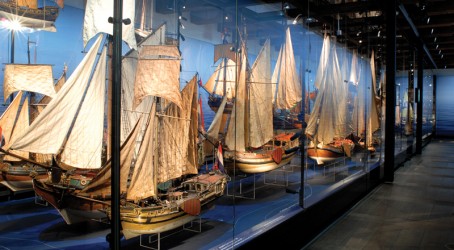Museums
People in the Netherlands have been celebrating the arrival of a new king and the reopening of their national gallery, the Rijksmuseum in Amsterdam, after a lengthy restoration. Meanwhile, the curators of another collection on the far side of the city have been cheered by winning a special commendation in the European Museum of the Year Awards.
It’s easy to spot the Dutch national maritime museum, Het Scheepvaartmuseum. Its elegant classical building rises out of the water alongside a three-masted sailing ship, the Amsterdam. You can clamber all over this replica of a Dutch East Indiaman. It’s astonishing to think that more than 350 sailors lived in the cramped space below deck on the original vessel before it sank on its maiden voyage in 1749.
The Amsterdam towers above Christiaan Brunings, a steamboat built in 1900 for inspecting the waterways of Zeeland. This immaculately preserved vessel resembles the pleasure boats from the same era that still ply the waters of Windermere in the Lake District, and doesn’t look tough enough for the ice-breaking duties that it was actually used for.
The museum building was used for centuries by the Dutch navy as a storehouse, to supply the fleet with everything from drinking water to cannons. The first thing that strikes the visitor entering today is the magnificent roof that was erected over the central courtyard during a recent renovation. No two glass panes are the same size, apparently. For a fix of heavy engineering, head for the noord side of the courtyard. Here there’s a bird’s-eye view of Amsterdam’s port, the fourth largest in Europe. Touchscreens allow you to home in on landmarks on an enormous map.
Then there is a shipping container to enter. There’s a disquieting moment when the doors shut. Will you be left inside? A voice tells you to hold on to the handrail as the experience may be disorientating. Suddenly, images appear on screens all around and you’re flying over the vast port, above thousands upon thousands of containers stacked in rows, in between cranes and over ships and barges. It’s a thrilling ride. There’s no commentary, but almost all the labels in the rest of the museum are in English as well as Dutch.
In a room nearby, giant, grainy black-and-white photos bring home the hard graft put in by generations of dockyard workers. In one image, men suspended by ropes scrape away at the side of a ship. In another, ironworkers, on a well-earned fag break, stand and stare at the camera. Close by are oil paintings of shipping magnates and stained-glass windows, which once graced company boardrooms.
Cross the courtyard to the west wing to see the story of the Netherlands as a superpower in the 17th and 18th centuries. During this so-called “golden age” there were endless wars against the English, French and Spanish, while Dutch maritime might brought colonisation to the Caribbean, East Indies and – for a while – part of Brazil.
This wing also houses the Tale of the Whale. You can walk into the belly of one of these enormous creatures and inspect the museum’s most gruesome exhibit – a steam saw once used to cut up whale bones. The oost wing offers many more treasures: paintings, globes, silver, glass and old photos.

5 things to see
- The Amsterdam: Climb aboard this replica sailing ship.
- Battle of Gibraltar: Glistening oil painting brings 17th-century war at sea to life.
- Navigational instruments: Find out how latitude and longitude were measured.
- Voyage at Sea: Take a bit part in this unmissable multimedia experience.
- Ship decorations: Marvel at craftsmanship in wood.